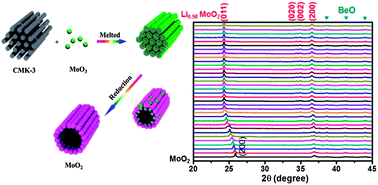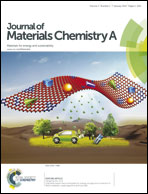Lithiation mechanism of hierarchical porous MoO2 nanotubes fabricated through one-step carbothermal reduction†
Abstract
A one-step carbothermal reduction method has been developed for the preparation of hierarchical porous materials. In this method, CMK-3 acts both as a template casting the hierarchical porous structure and as a reducing agent for the carbothermal reaction. Hierarchical MoO2 nanotubes prepared through this method exhibit high charge/discharge capacities and rate capabilities when used as an anode material for lithium ion batteries. Cycled at current densities of 0.1 and 1.0 A g−1, the material delivers discharge capacities of 720 and 530 mA h g−1 after 70 cycles, respectively. The Li-ion insertion and extraction processes of MoO2 nanotubes have been investigated by using an in situ X-ray diffraction technique for the first time to elucidate the Li-ion storage mechanism for the MoO2 material. We demonstrate that the discharge capacity increase of MoO2 during the first 30 cycles is attributed to the lithiation transformation of MoO2.


 Please wait while we load your content...
Please wait while we load your content...